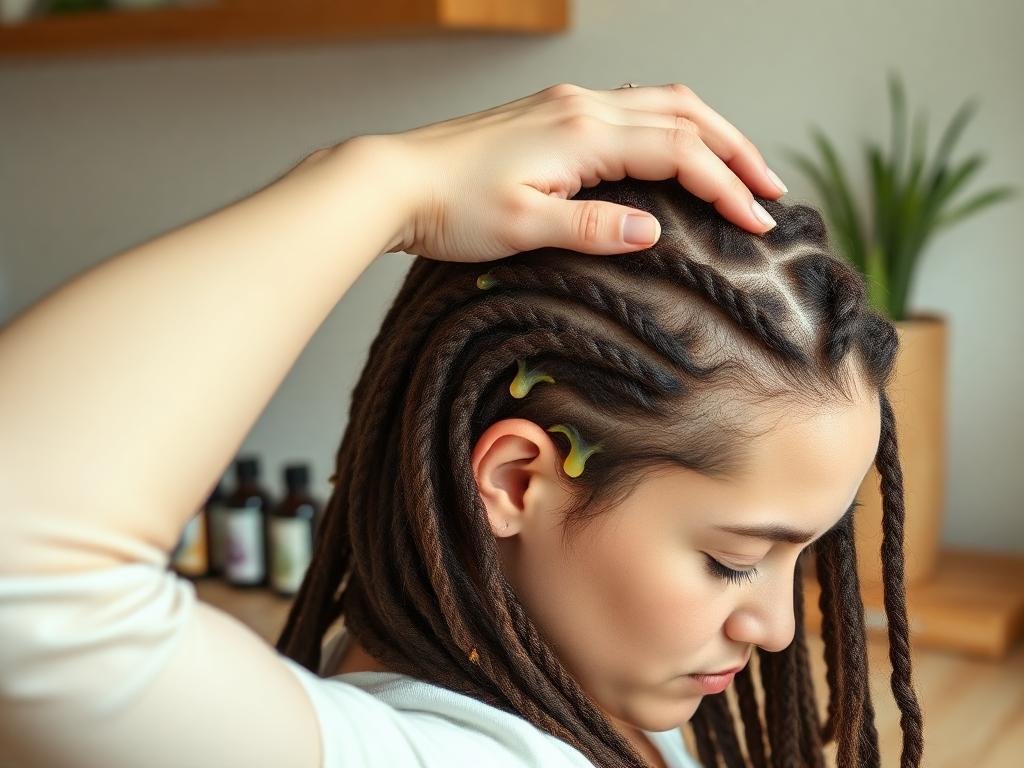Introduction to Dreadlocked Scalps and Their Care
Dreadlocks, often referred to as “dreads,” are a unique and intricate hairstyle that involves matting and twisting hair into rope-like strands. When it comes to taking care of dreadlocks, special attention must be paid to both the hair and the scalp. The scalp plays a crucial role in the overall health of your dreadlocks, as it is the foundation from which your hair grows. A healthy, nourished scalp promotes hair growth, prevents dryness, itching, and flakiness, and ensures that your locks remain strong and well-maintained.
One of the most important aspects of scalp care is choosing the right oils for nourishment. The oils you use can hydrate the scalp, soothe irritation, control dandruff, and even promote hair growth. Now, let’s get into the details.

Foundational Concepts: Understanding the Dreadlocked Scalp
1. Scalp Anatomy and Function
- The Scalp: The scalp is the skin on the top of your head, housing hair follicles where your hair grows. It contains sebaceous glands that produce natural oils (sebum) that moisturize the hair and scalp.
- Common Scalp Issues:
- Dryness: Can lead to itching and flaking.
- Build-up: Sweat, product residues, or dust can accumulate, leading to discomfort or even scalp issues.
- Itching: Often caused by dryness or product build-up.
- Dandruff: Flaky skin on the scalp due to dryness or fungal infections.
2. Why Oils Matter
Oils play a crucial role in maintaining a healthy scalp. They help:
- Hydrate: Oil prevents the scalp from becoming dry and flaky.
- Nourish: They provide essential fatty acids and vitamins to your scalp and hair.
- Sooth irritation: Oils like tea tree and peppermint are natural anti-inflammatory agents.
- Promote hair growth: Some oils stimulate blood circulation to the scalp, promoting healthier hair growth.
Intermediate Concepts: Selecting the Right Oils for Dreadlocked Scalp Care
Now that you understand the basics, let’s discuss specific oils and their benefits for dreadlocked scalps. Different oils have different properties, and choosing the right one depends on your scalp’s needs.
1. Best Oils for Dreadlocked Scalps
-
Coconut Oil:
- Why it’s good: Coconut oil is one of the most popular oils for scalp care due to its deep moisturizing properties. It contains fatty acids like lauric acid, which penetrate the hair shaft to hydrate both hair and scalp. It’s also antifungal and antibacterial, making it great for preventing scalp infections and dandruff.
- How to use: Apply a small amount to the scalp, massaging it in gently. Leave it on for at least 30 minutes (or overnight) before washing it out.
-
Jojoba Oil:
- Why it’s good: Jojoba oil is closest to the scalp’s natural sebum, making it excellent for balancing oil production. It’s lightweight, non-greasy, and won’t clog pores, which is vital for dreadlocks.
- How to use: Jojoba oil can be used as a leave-in treatment. Apply a few drops directly to the scalp and massage it in. It can also be mixed with other oils.
-
Tea Tree Oil:
- Why it’s good: Tea tree oil has antifungal and antimicrobial properties, which makes it great for treating dandruff and scalp infections. It also helps soothe itching and irritation.
- How to use: Dilute tea tree oil with a carrier oil (such as coconut or jojoba oil) before applying it to the scalp. Use 2-3 drops of tea tree oil for every tablespoon of carrier oil.
-
Argan Oil:
- Why it’s good: Argan oil is rich in vitamin E and antioxidants. It is a great moisturizer for dry scalp and hair, reducing frizz and improving scalp elasticity.
- How to use: Apply a few drops of argan oil to your scalp and massage gently.
-
Peppermint Oil:
- Why it’s good: Peppermint oil has a cooling effect that soothes itching and irritation. It also stimulates blood circulation, which can encourage hair growth.
- How to use: Like tea tree oil, peppermint oil should be diluted with a carrier oil before applying. A few drops mixed with coconut or olive oil can be massaged into the scalp.
-
Olive Oil:
- Why it’s good: Olive oil is a heavier oil that is great for dry scalps, as it deeply nourishes and softens. It also contains antioxidants that protect against oxidative stress.
- How to use: Warm the olive oil slightly and apply it to the scalp. Leave it on for 30 minutes to an hour before washing it out.
2. Combination of Oils
You can also create custom oil blends to address specific scalp concerns. For example, a combination of coconut oil, tea tree oil, and peppermint oil can target dryness, itching, and dandruff. Here’s a simple recipe for a scalp treatment:
- Ingredients:
- 1 tbsp coconut oil
- 1 tsp tea tree oil
- 2-3 drops peppermint oil
- Instructions: Mix all oils and massage into the scalp. Leave on for 20-30 minutes before washing.
Advanced Concepts: The Art of Oil Application & Scalp Care
Now that you understand the best oils for your dreadlocked scalp, let’s dive into advanced techniques and tips for ensuring the best results.
1. How to Massage Your Scalp Properly
- Why it’s important: Massaging your scalp promotes blood circulation, which nourishes the hair follicles and stimulates hair growth. It also helps distribute the oil evenly.
- Technique: Use your fingertips (not nails) to massage in small circular motions. Apply gentle pressure, focusing on areas that feel dry or irritated. Spend 5-10 minutes massaging the entire scalp.
2. Avoid Over-Oiling
- Why it’s a common mistake: Over-applying oil can lead to clogged pores, build-up in your dreadlocks, and cause the hair to feel greasy. Dreadlocks need some oil, but a little goes a long way.
- How much oil: Start with a small amount (a few drops) and add more if needed. You should not see excess oil sitting on your scalp or hair.
3. Cleaning Your Scalp
- Regularly cleaning your scalp is essential, especially with dreadlocks, where build-up can occur more easily.
- Shampooing: Use a residue-free shampoo or clarifying shampoo to cleanse the scalp of oil and product build-up.
- Frequency: Wash your hair once every 1-2 weeks to avoid stripping the scalp of its natural oils.
4. Understanding the Timing
- How long to leave the oils on: For deep hydration and nourishment, leave oils on the scalp for at least 30 minutes to an hour. If possible, you can leave oils overnight for an intensive treatment.
- Overnight Oil Treatment: If you choose to leave oil overnight, wrap your hair in a satin or cotton scarf to prevent staining your pillow.
5. Maintaining Healthy Dreads
- Regular Maintenance: Ensure your locks are properly maintained and don’t get too tight, as this can cause tension on the scalp. Regularly inspect your scalp for any build-up and address it promptly with oil treatments or scalp cleansers.
Expert Insights: Key Takeaways
- Consistency is key. Stick to a routine of scalp massages and oil treatments for optimal results.
- Start small. Always begin with a small amount of oil to gauge your scalp’s response, and gradually increase as needed.
- Choose oils based on your scalp’s needs. If your scalp is dry, go for moisturizing oils like coconut and jojoba. If you’re dealing with itchiness or dandruff, incorporate tea tree or peppermint oils.
- Avoid harsh chemicals. Opt for natural oils instead of products that contain artificial fragrances or harsh additives.
Practical Exercises for Mastery
- Daily Scalp Massage Practice: Commit to a 5-minute scalp massage every morning or evening using your favorite oil. Take note of how your scalp feels before and after.
- Oil Blend Experimentation: Try blending different oils and observe how your scalp responds. Keep a journal of the results and any noticeable improvements.
- Scalp Inspection: Once a week, inspect your scalp for build-up or irritation. Clean it gently if needed, and use oil treatments to nourish it afterward.
By practicing these techniques and incorporating the right oils into your routine, you will become a master at maintaining a healthy dreadlocked scalp. You’ve now got the foundation and advanced knowledge to ensure your scalp and locks stay healthy, nourished, and strong. Would you like me to assist with anything further, such as a specific oil recipe or an advanced oil blending guide?

hi
Hey! How can we help you?